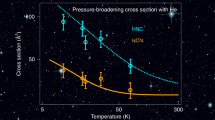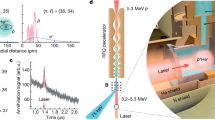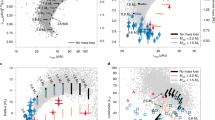Abstract
ALL the lines of neutral helium that can be observed in stellar spectra belong to some of the subordinate series. The ultimate lines (lS-mP) are in the far ultra-violet and cannot be photographed through the earth's atmosphere. The diffuse series of both the triplet system (2p3 - md3) and the singlet system (2P - mD) have nearly identical lower energy levels, the excitation potentials being 20·81 volts and 21·12 volts respectively (cf. H. N. Russell, Astroph. Jour., 61, 223; 1925). Accordingly, the corresponding lines of these two series should show identical intensity curves with respect to temperature, the intensity ratio of the triplet line to the singlet line remaining constant (cf. R. H. Fowler and E. A. Milne, Mon. Not. R.A.S., 83, 415; 1923).
This is a preview of subscription content, access via your institution
Access options
Subscribe to this journal
Receive 51 print issues and online access
$199.00 per year
only $3.90 per issue
Buy this article
- Purchase on Springer Link
- Instant access to full article PDF
Prices may be subject to local taxes which are calculated during checkout
Similar content being viewed by others
Author information
Authors and Affiliations
Rights and permissions
About this article
Cite this article
STRUVE, O. The Helium Lines in Stellar Spectra. Nature 122, 994–995 (1928). https://doi.org/10.1038/122994a0
Issue Date:
DOI: https://doi.org/10.1038/122994a0
Comments
By submitting a comment you agree to abide by our Terms and Community Guidelines. If you find something abusive or that does not comply with our terms or guidelines please flag it as inappropriate.



